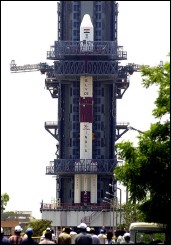Lost lakes of Titan are found at last

This colorized radar view from Cassini shows lakes on Titan. Color intensity is proportional to how much radar brightness is returned. The colors are not a representation of what the human eye would see. Image credit: NASA/JPL/USGS
Lakes of methane have been spotted on Saturn's largest moon, Titan, boosting the theory that this strange, distant world bears beguiling similarities to Earth, according to a new study.
Titan has long intrigued space scientists, as it is the only moon in the Solar System to have a dense atmosphere -- and its atmosphere, like Earth's, mainly comprises nitrogen.
Titan's atmosphere is also rich in methane, although the source for this vast store of hydrocarbons is unclear.
Methane, on the geological scale, has a relatively limited life. A molecule of the compound lasts several tens of millions of years before it is broken up by sunlight.
Given that Titan is billions of years old, the question is how this atmospheric methane gets to be renewed. Without replenishment, it should have disappeared long ago.
A popular hypothesis is that it comes from a vast ocean of hydrocarbons.
But when the US spacecraft Cassini sent down a European lander, Huygens, to Titan in 2005, the images sent back were of a rugged landscape veiled in an orange haze.
There were indeed signs of methane flows and methane precipitation, but nothing at all that pointed to any sea of the stuff.
But a flyby by Cassini on July 22 last year has revealed, thanks to a radar scan, 75 large, smooth, dark patches between three and 70 kilometers across (two and 42 miles) across that appear to be lakes of liquid methane, scientists report on Thursday.
They believe the lakes prove that Titan has a "methane cycle" -- a system that is like the water cycle on Earth, in which the liquid evaporates, cools and condenses and then falls as rain, replenishing the surface liquid.
As on Earth, Titan's surface methane may well be supplemented by a "table" of liquid methane that seeps through the rock, the paper suggests.
Some of the methane lakes seem only partly filled, and other depressions are dry, which suggests that, given the high northerly latitudes where they were spotted, the methane cycle follows Titan's seasons.
In winter, the lakes expand, while in summer, they shrink or dry up completely -- again, another parallel with Earth's hydrological cycle.
The study, which appears on Thursday in the British weekly journal Nature, is headed by Ellen Stofan of Proxemy Research in Virginia and University College London.
Titan and Earth are of course very different, especially in their potential for nurturing life. Titan is frigid, dark and, as far as is known, waterless, where as Earth is warm, light and has lots of liquid water.
But French astrophysicist Christophe Sotin says both our planet and Titan have been sculpted by processes that, fundamentally, are quite similar.
The findings "add to the weight of evidence that Titan is a complex world in which the interaction between the inner and outer layers is controlled by processes similar to those that must have dominated the evolution of any Earth-like planet," Sotin said in a commentary.
"Indeed, as far as we know," Sotin added, "there is only one planetary body that displays more dynamism than Titan. Its name is Earth."





 The findings, reported in the journal Science, come from the first analysis of dust fragments from Comet Wild-2, captured by NASA's Stardust spacecraft and brought to Earth in January 2006. Because comets are among the oldest objects in the Solar System, the team, which includes researchers from Imperial College London and the Natural History Museum, believes their sample of dust can provide insights into how Earth and other planets came to be formed.
The findings, reported in the journal Science, come from the first analysis of dust fragments from Comet Wild-2, captured by NASA's Stardust spacecraft and brought to Earth in January 2006. Because comets are among the oldest objects in the Solar System, the team, which includes researchers from Imperial College London and the Natural History Museum, believes their sample of dust can provide insights into how Earth and other planets came to be formed. 
